The Hellenic Marine Observing, Forecasting and Technology System—An Integrated Infrastructure for Marine Research
Abstract
:1. Introduction
2. HIMIOFoTS, a Large-Scale Integrated Research Infrastructure for the Management of the National Water Resources
3. The Hellenic Marine Observing, Forecasting and Offshore Technology System
- The Hellenic Centre for Marine Research (HCMR) provides the observing platforms and the forecasting systems of the POSEIDON system, the operational monitoring, forecasting and information system for the Greek Seas;
- The University of the Aegean provides the HF radar installed in Lemnos Island to monitor the Black Sea water outflow in the Aegean;
- The Harokopio University of Athens upgraded the weather forecasting system;
- The National and Kapodistrian University of Athens contributes with the infrastructure for coastal zone monitoring and management;
- The National Technical University of Athens supports testing and ocean engineering through a land-based facility.
3.1. The Observing System
3.1.1. The POSEIDON Observing Network
3.1.2. The “Dardanos” System
- The receiver arrays, initially composed of four antennas deployed on a square configuration, were replaced by linear arrays composed of eight antennas on every site.
- The transmitting frequency was moved to 16.1 MHz, thus providing a slightly smaller range but in a much less noisy electromagnetic environment.
- One of the major improvements in using eight antennas oriented in a linear array is the ability to use both direction-finding and beam-forming techniques, thus exploiting the advantages of both.
- The beam-forming technique enables the assessment of wave characteristics over a region smaller than the region of current coverage.
- Indirect products may include wind stress, mixed layer depth [17] and possibly other parameters.
3.2. The Forecasting System
- The POSEIDON weather forecasting system [18] with simulation period of 5 days.
- The Mediterranean ocean circulation forecasting system [19], which provides 5-day forecasts.
- The WAM based wave forecasting system provides wave forecasts for the next 5 days forced with hourly forecast winds produced by the POSEIDON weather prediction system.
- The WAVEWATCH based wave forecasting system provides wave forecasts for the next 5 days forced with hourly analysis and forecast winds produced by the POSEIDON weather prediction system.
- The oil spill fate and trajectory model, which is able to simulate not only the drift of the oil but also the chemical transformations under the specific environmental conditions.
- The weather system was further improved through a major upgrade of the Local Analysis and Prediction System (LAPS) 3D data assimilation package implemented by the Harokopio University of Athens, enhancing the high-resolution analysis fields. The LAPS domain covers all of Europe and is configured to run with GFS forecasts as background fields assimilating METAR, SYNOP and RAOB measurements in real time. Moreover, the POSEIDON weather forecasting system was ported to a new High Performance Computer System (HPC) to ensure faster execution and better stability.
- A new forecasting system was developed covering both the Aegean and the Ionian Seas based on the hydrodynamic model Regional Ocean Modeling System (ROMS version 3.7).
- A high-resolution offline model was developed covering the Gulf of Saronikos and embedded into the above system.
3.2.1. The Weather Forecasting System
3.2.2. The Circulation Forecasting System
3.2.3. The WAM Wave Forecasting System and Its Quality Assessment
3.3. Coastal Zone Management
3.4. The Marine Land-Based Facility for Testing and Marine Engineering
- Calibration of wave buoys, floats and sea current meters.
- Examination of the floatation and performance of submerged instruments such as ocean gliders.
- Hydrodynamic design of buoys, floaters, conventional ships (design of hull forms, bulbous bows, sponsons, appendages, etc.).
- Reproduction of the wave climate in a sea region and determination of the corresponding ship operability.
- Hydrodynamic design of modern ships (fast and planning ships, single hull and catamaran).
- Design of ship propulsion systems. Optimization of the ship lines with respect to her seakeeping qualities.
- Special measurements on board of ships and floating structures using modern data acquisition systems.
4. Current Status for Services and Accessibility
4.1. Weather, Ocean and Sea State Forecasting Services
4.2. Search and Rescue
4.3. The Oil Spill Forecasting Service
4.4. Ocean Data
4.5. Calibration Services
4.6. Open Access to Ocean Platforms and Field Experiments
4.7. Field Equipment/Laboratory Infrastructure for Coastal Zone Monitoring
4.8. The Database of the Coastal Zone
- (A).
- Gridded data
- (i)
- Data obtained by analyzing in situ observations
- (ii)
- Data obtained by model
- (B).
- Network of available coastal information
- (i)
- Result information from in situ measurements and observations
5. The Roadmap to the Future Evolution
Author Contributions
Funding
Informed Consent Statement
Data Availability Statement
Conflicts of Interest
References
- General Secretariat for Research and Technology. National Roadmap for Research Infrastructures; GSRT: Athens, Greece, 2014. [Google Scholar]
- Davidson, F.; Alvera-Azcárate, A.; Barth, A.; Brassington, G.B.; Chassignet, E.P.; Clementi, E.; De Mey-Frémaux, P.; Divakaran, P.; Harris, C.; Hernandez, F.; et al. Synergies in Operational Oceanography: The Intrinsic Need for Sustained Ocean Observations. Front. Mar. Sci. 2019, 6, 450. [Google Scholar] [CrossRef] [Green Version]
- Soukissian, T.H.; Chronis, G. Poseidon: A marine environmental monitoring, forecasting and information system for the Greek seas. Mediterr. Mar. Sci. 2000, 1, 71–78. [Google Scholar] [CrossRef]
- Kalantzi, G.; Soukissian, T.H.; Nittis, K. Assessment of surface circulation using remote-sensed data, in-situ measurements and directional statistics. Int. J. Mol. Sci. 2010, 39, 15–26. [Google Scholar]
- Petihakis, G.; Perivoliotis, L.; Korres, G.; Ballas, D.; Frangoulis, C.; Pagonis, P.; Ntoumas, M.; Pettas, M.; Chalkiopoulos, A.; Sotiropoulou, M.; et al. An integrated open-coastal biogeochemistry, ecosystem and biodiversity observatory of the eastern Mediterranean-the Cretan Sea component of the POSEIDON system. Ocean Sci. 2018, 14, 1223–1245. [Google Scholar] [CrossRef] [Green Version]
- Kassis, D.; Korres, G. Hydrography of the Eastern Mediterranean basin derived from argo floats profile data. In Deep Sea Research Part. Ii: Topical Studies In Oceanography; Elsevier: Amsterdam, The Netherlands, 2020; Volume 171, p. 104712. [Google Scholar]
- Stewart, R.H.; Joy, J.W. HF radio measurements of surface currents. Deep-Sea Res. 1974, 21, 1039–1049. [Google Scholar] [CrossRef]
- Barrick, D.E.; Evans, M.W. Ocean surface currents mapped by Radar. Science 1977, 198, 138–144. [Google Scholar] [CrossRef]
- Bellomo, L.; Griffa, A.; Cosoli, S.; Falco, P.; Gerin, R.; Iermano, I.; Kalampokis, A.; Kokkini, Z.; Lana, A.; Magaldi, M.G.; et al. Toward an integrated HF radar network in the Mediterranean sea to improve search and rescue and oil spill response: The TOSCA project experience. J. Oper. Oceanogr. 2015, 8, 95–107. [Google Scholar] [CrossRef]
- Kokkini, Z.; Potiris, M.; Kalampokis, A.; Zervakis, V. HF radar observations of the dardanelles outflow current in the north eastern aegean using validated WERA HF radar data. Mediterr. Mar. Sci. 2014, 15, 753–768. [Google Scholar] [CrossRef] [Green Version]
- Tzali, M.; Sofianos, S.; Mantziafou, A.; Skliris, N. Modelling the Impact of Black Sea Water Inflow on the North Aegean Sea Hydrodynamics. Ocean Dyn. 2010, 60, 585–596. [Google Scholar] [CrossRef]
- Zervakis, V.; Georgopoulos, D.; Drakopoulos, P.G. The Role of the North Aegean in Triggering the Recent Eastern Mediterranean Climatic Changes. J. Geophys. Res. Ocean. 2000, 105, 26103–26116. [Google Scholar] [CrossRef]
- Ignatiades, L.; Psarra, S.; Zervakis, V.; Pagou, K.; Souvermezoglou, E.; Assimakopoulou, G.; Gotsis-Skretas, O. Phytoplankton Size-Based Dynamics in the Aegean Sea (Eastern Mediterranean). J. Mar. Syst. 2002, 36, 11–28. [Google Scholar] [CrossRef]
- Siokou-Frangou, I.; Bianchi, M.; Christaki, U.; Christou, E.D.; Giannakourou, A.; Gotsis, O.; Ignatiades, L.; Pagou, K.; Pitta, P.; Psarra, S.; et al. Carbon Flow in the Planktonic Food Web Along a Gradient of Oligotrophy in the Aegean Sea (Mediterranean Sea). J. Mar. Syst. 2002, 33–34, 335–353. [Google Scholar] [CrossRef]
- Siokou-Frangou, I.; Zervoudaki, S.; Christou, E.D.; Zervakis, V.; Georgopoulos, D. Variability of Mesozooplankton Spatial Distribution in the North Aegean Sea, as Influenced by the Black Sea Waters Outflow. J. Mar. Syst. 2009, 78, 557–575. [Google Scholar] [CrossRef]
- Gürgel, K.W.; Antonischki, G.; Essen, H.-H.; Schlick, T. Wellen Radar (WERA), a new ground-wave based HF radar for ocean remote sensing. Coast. Eng. 1999, 37, 219–234. [Google Scholar] [CrossRef]
- Zervakis, V.; Kokkini, Z.; Potiris, E. Estimating Mixed Layer Depth with the use of a Coastal High-Frequency Radar. Cont. Shelf Res. 2017, 149, 4–16. [Google Scholar] [CrossRef]
- Papadopoulos, A.; Katsafados, P.; Mavromatidis, E.; Kallos, G. Assessing the skill of the POSEIDON-II weather forecasting system. In Proceedings of the Fifth International Conference on EuroGOOS, Exeter, UK, 22–20 May 2008. [Google Scholar]
- Korres, G.; Tsiaras, K.; Nittis, K.; Triantafyllou, G.; Hoteit, I. The POSEIDON-II system: Forecasting at the Mediterranean scale. In Proceedings of the 5th EuroGoos Conference, Exeter, UK, 20–22 May 2008. [Google Scholar]
- Nittis, K.; Perivoliotis, L.; Korres, G.; Tziavos, C.; Thanos, I. Operational monitoring and forecasting for marine environmental applications in the Aegean Sea. Environ. Modell. Softw. 2006, 21, 243–257. [Google Scholar] [CrossRef]
- Korres, G.; Lascaratos, A.; Hatziapostolou, E.; Katsafados, P. Towards an Ocean Forecasting System for the Aegean Sea. Glob. Atmos. Ocean Syst. 2002, 8, 191–218. [Google Scholar] [CrossRef]
- Albers, S. The LAPS wind analysis. Wea. Forecast. 1995, 10, 342–352. [Google Scholar] [CrossRef] [Green Version]
- Janjic, Z.I.; Gerrity, J.P., Jr.; Nickovic, S. An Alternative Approach to Nonhydrostatic Modeling. Mon. Wea. Rev. 2001, 129, 1164–1178. [Google Scholar] [CrossRef]
- Kallos, G.; Papadopoulos, A.; Nickovic, S.; Katsafados, P. Trans-Atlantic North African dust transport: Model simulation. J. Geophys. Res. 2006, 111, D09204. [Google Scholar] [CrossRef] [Green Version]
- Spyrou, C.; Varlas, G.; Pappa, A.; Mentzafou, A.; Katsafados, P.; Papadopoulos, A.; Anagnostou, M.N.; Kalogiros, J. Implementation of a nowcasting hydrometeorological system for studying flash flood events: The Case of Mandra, Greece. Remote Sens. 2020, 12, 2784. [Google Scholar] [CrossRef]
- Haidvogel, D.B.; Arango, H.G.; Hedstrom, K.; Beckmann, A.; Malanotte-Rizzoli, P.; Shchepetkin, A.F. Model evaluation experiments in the North Atlantic Basin: Simulations in nonlinear terrain-following coordinates. Dyn. Atmos. Ocean. 2000, 32, 239–281. [Google Scholar] [CrossRef]
- Shchepetkin, A.F.; McWilliams, J.C. A method for computing horizontal pressure-gradient force in an oceanic model with a nonaligned vertical coordinate. J. Geophys. Res. 2003, 108, 3090. [Google Scholar] [CrossRef]
- Shchepetkin, A.F.; McWilliams, J.C. The Regional Ocean Modeling System: A split-explicit, free-surface, topography following coordinates ocean model. Ocean Model. 2005, 9, 347–404. [Google Scholar] [CrossRef]
- Maderich, V.; Ilyin, Y.; Lemeshko, E. Seasonal and interannual variability of the water exchange in the turkish straits system estimated by modelling. Mediterr. Mar. Sci. 2015, 16, 444–459. [Google Scholar] [CrossRef] [Green Version]
- Egbert, G.D.; Erofeeva, S.Y. Efficient inverse modeling of barotropic ocean tides. J. Atmos. Ocean. Technol. 2002, 19, 183–204. [Google Scholar] [CrossRef] [Green Version]
- Papadopoulos, A.; Katsafados, P.; Kallos, G.; Nickovic, S. The weather forecasting system for POSEIDON-An overview. Glob. Atmos. Ocean Syst. 2002, 8, 219–237. [Google Scholar] [CrossRef]
- Lindstrom, G.; Pers, C.; Rosberg, J.; Strmqvist, J.; Arheimer, B. Development and testing of the HYPE (Hydrological Predictions for the Environment) water quality model for different spatial scales. Hydrol. Res. 2010, 41, 295–319. [Google Scholar] [CrossRef]
- Booij, N.; Ris, R.C.; Holthuijsen, L.H. A third-generation wave model for coastal regions: 1. Model description and validation. J. Geophys. Res. 1999, 104, 7649–7666. [Google Scholar] [CrossRef] [Green Version]
- Gürol, S.; Weaver, A.T.; Moore, A.M.; Piacentini, A.; Arango, H.G.; Gratton, S. B-preconditioned minimization algorithms for variational data assimilation with the dual formulation. Q. J. R. Meteorol. Soc. 2014, 140, 539–556. [Google Scholar] [CrossRef] [Green Version]
- WAMDI Group. The WAM Model—A Third Generation Ocean Wave Prediction Model. J. Phys. Oceanogr. 1988, 18, 1775–1810. [Google Scholar] [CrossRef] [Green Version]
- Komen, G.J.; Cavaleri, L.; Donelan, M.; Hasselmann, K.; Hasselmann, S.; Janssen, P. Dynamics and Modelling of Ocean Waves; Cambridge University Press: Cambridge, UK, 1994. [Google Scholar]
- Grashoff, K.; Kremling, K.; Ehrhardt, M. Methods of Seawater Analysis; Wiley-VCH: Hoboken, NJ, USA, 1999; pp. 159–209. [Google Scholar]
- Ladakis, M.; Dassenakis, M.; Pantazidou, A. Nitrogen, and phosphorus in coastal sediments covered by algal mat. J. Soils Sediments 2006, 6, 46–54. [Google Scholar] [CrossRef]
- Diamantopoulou, E.; Dassenakis, M.; Paraskevopoulou, V.; Rouselakis, E.; Tomara, V. Heavy metals behaviour and distribution in a shallow Mediterranean lagoon. Fresenius Environ. Bull. 2008, 17, 1717–1724. [Google Scholar]
- Matiatos, I.; Paraskevopoulou, V.; Lazogiannis, K.; Botsou, F.; Dassenakis, M.; Ghionis, G.; Alexopoulos, J.D.; Poulos, S.E. Surface-ground water interactions and hydrogeochemical evolution in a fluvio-deltaic setting: The case study of Pinios River Delta. J. Hydrol. 2018, 561, 236–249. [Google Scholar] [CrossRef]
- APHA. Standard Methods for the Examination of Water and Wastewater; American Public Health Association: Washinghton, DC, USA, 2005; Volume 198, pp. 138–144. [Google Scholar]
- Koukounari, I.N.; Paraskevopoulou, V.; Karditsa, A.; Koulouri, P.; Poulos, S.E.; Dounas, C.G.; Dassenakis, M. Trace metal concentrations in the offshore surficial sediments of Heraklion Gulf (Crete Island, East Mediterranean Sea). Mediterr. Mar. Sci. 2020, 21, 84–104. [Google Scholar] [CrossRef]
- Paraskevopoulou, V.; Zeri, C.; Kaberi, H.; Chalkiadaki, O.; Krasakopoulou, E.; Dassenakis, M.; Scoullos, M. Trace metal variability, background levels and pollution status assessment in line with the Water Framework and Marine Strategy Framework EU Directives in the waters of a heavily impacted Mediterranean Gulf. Mar. Pollut. Bull. 2014, 87, 323–337. [Google Scholar] [CrossRef] [PubMed]
- Chalkiadaki, O.; Dassenakis, M.; Lydakis-Simantiris, N. Bioconcentration of Cd and Ni in various tissues of two marine bivalves living in different habitats and exposed to heavily polluted seawater. Chem. Ecol. 2014, 30, 726–742. [Google Scholar] [CrossRef] [Green Version]
- Sakellari, A.; Karavoltsos, S.; Theodorou, D.; Dassenakis, M.; Scoullos, M. Bioaccumulation of metals (Cd, Cu, Zn) by the marine bivalves M. galloprovincialis, P. radiata, V. verrucosa and C. chione in Mediterranean coastal microenvironments association with metal bioavailability. Environ. Monitor. Assess. 2013, 185, 3383–3395. [Google Scholar] [CrossRef]
- Diamantopoulou, E.; Dassenakis, M.; Kastritis, A.; Tomara, V.; Paraskevopoulou, V. Seasonal fluctuations of nutrients in a hypersaline Mediterranean lagoon. Desalination 2008, 224, 271–279. [Google Scholar] [CrossRef]
- Kandyliari, A.; Karavoltsos, S.; Sakellari, A.; Anastasiadis, P.; Asderis, M.; Papandroulakis, N.; Kapsofefalou, M. Trace metals in six fish by-products of two farmed fishes, the gilthead sea bream (Sparus aurata) and the meager (Argyrosomus regius): Interactions with the environment and feed. Hum. Ecol. Risk Assess. Int. J. 2021, 27, 1126–1146. [Google Scholar] [CrossRef]
- Dassenakis, M.; Paraskevopoulou, V.; Botsou, F.; Chalkiadaki, O.; Tzempelikou, E.; Stathopoulou, E.; Bilias, G.; Scoullos, M. Mercury levels in Greek coastal areas. In Proceedings of the International Conference Environmental Perspectives of the Gulf of Elefsis. A Mediterranean Case Study Where Science Meets the Society. Elefsis, Greece, 11–12 September 2015; Special Issue of the Sustainable Mediterranean Journal; MIO-ECSDE: Athens, Greece, 2015. [Google Scholar]
- Environmental Protection Agencty. Method 1631, Revision E: Mercury in Water by Oxidation, Purge and Trap, and Cold Vapor Atomic Fluorescence Spectrometry; EPA-821-R-02-019; Office of Water 4303, Environmental Protection Agency: Washington, DC, USA, 2002.
- Panagopoulou, G.; Paraskevopoulou, V.; Chalkiadaki, O.; Botsou, F.; Scoullos, M.D.E. Total mercury in seawater and sediments of Saronijkos Gulf. In Proceedings of the 14th International Conference o n Mercury as a Global Pollutant (ICMGP 2019), Krakow, Poland, 8–13 September 2019; Volume 250, p. 169. [Google Scholar]
- Yfanti, A.; Paraskevopoulou, V.; Chalkiadaki, O.; Botsou, F.; Panagopoulou, G.I.; Stathopoulou, E.; Zeri, C.; Tzempelikou, E.; Dassenakis, M. Mercury in the coastal waters of Greece under the implementation of the Water Framework Directive (WFD). In Proceedings of the 17th International Conference on Environmental Science and Technology, CEST2021, Athens, Greece, 1–4 September 2021. [Google Scholar]
- Bianchi, C.N.; Morri, C. Marine Biodiversity of the Mediterranean Sea: Situation, Problems and Prospects for Future Research. Mar. Pollut. Bull. 2000, 40, 367–376. [Google Scholar] [CrossRef]
- Megalofonou, P. Comparison of otolith growth and morphology with somatic growth and age in young-of-the-year bluefin tuna. J. Fish Biol. 2006, 68, 1867–1878. [Google Scholar] [CrossRef]
- Armiger, H.; Hartill, B.; Rush, N.; Vaughan, M.; Smith, M.; Buckthought, D. Length and age compositions of recreational landings of kahawai in KAH 1 in January to April 2008 and KAH 8 in January to April 2007. N. Z. Fish. Assess. Rep. 2009, 36, 40. [Google Scholar] [CrossRef]
- Milatou, N.; Megalofonou, P. Age structure and growth of bluefin tuna (Thunnus thynnus L.) in the capture-based aquaculture in the Mediterranean Sea. Aquaculture 2014, 424–425, 35–44. [Google Scholar] [CrossRef]
- Rodríguez-Marín, E.; Di Natale, A.; Quelle, P.; Ruiz, M.; Allman, R.; Bellodi, A.; Busawon, D.; Farley, J.; Garibaldi, F.; Ishihara, T.; et al. Report of the age calibration exchange within the Atlantic Wide Research Programme for bluefin tuna (GBYP) (SCRS/2014/150). 2014. [Google Scholar] [CrossRef]
- Megalofonou, P. Age and growth of Mediterranean albacore. J. Fish Biol. 2000, 57, 1–17. [Google Scholar] [CrossRef]
- Kousteni, V.; Megalofonou, P. Reproductive strategy of Scyliorhinus canicula (L., 1758): A holistic approach based on macroscopic measurements and microscopic observations of the reproductive organs. Mar. Freshw. Res. 2020, 71, 596–616. [Google Scholar] [CrossRef]
- Ghionis, G.; Trygonis, V.; Karydis, A.; Vousdoukas, M.; Alexandrakis, G.; Drakopoulos, P.; Andreadis, O.; Psarros, F.; Velegrakis, A.; Poulos, S. An integrated multispectral video and environmental monitoring system for the study of coastal processes and the support of beach management operations. Geophysical Research Abstracts. In Proceedings of the EGU General Assembly, EGU2016-17240, Vienna Austria, 17–22 April 2016; Volume 18. [Google Scholar]
- Trygonis, V.; Ghionis, G.; Andreadis, O.; Vousdoukas, M.; Ntemogiannis, I.; Rigos, A.; Psarros, F.; Velegrakis, A.; Hasiotis, T.; Poulos, S.E. Monitoring beach usage with a coastal video imaging system: An application at Paralia Katerinis. In Proceedings of the 11th Panhellenic Symposium on Oceanography and Fisheries, Mytilene, Lesvos island, Greece, 13–17 May 2015; pp. 737–740. [Google Scholar]
- Paramana, T.; Karditsa, A.; Milatou, N.; Petrakis, S.; Megalofonou, P.; Poulos, S.; Dassenakis, M. Creating the base for MSP; depicting the environmental status of Inner Ionian-Korinthiakos Gulf. In Proceedings of the 17th International Conference on Environmental Science and Technology, CEST2021, Athens, Greece, 1–4 September 2021. [Google Scholar]
- Paramana, T.; Karditsa, A.; Milatou, N.; Petrakis, S.; Megalofonou, P.; Poulos, S.; Dassenakis, M. MSFD In-Depth Knowledge of the Marine Environment as the Stepping Stone to Perform Marine Spatial Planning in Greece. Water 2021, 13, 2084. [Google Scholar] [CrossRef]
- Dassenakis, M.; Poulos, S.; Megalofonou, P.; Paramana, T.; Karditsa, A.; Petrakis, S.; Milatou, N. Environmental status of Lakonikos Gulf in connection to MSP. In Proceedings of the 14th MEDCOAST Congress on Coastal and Marine Sciences, Engineering, Management and Conservation, MEDCOAST 2019, Marmaris, Turkey, 22–26 October 2019; Volume 1, pp. 361–372. [Google Scholar]
- Gorjanc, S.; Klančnik, K.; Murillas-Maza, A.; Uyarra, M.C.; Papadopoulou, N.K.; Paramana, T.; Smith, C.; Chalkiadaki, O.; Dassenakis, M.; Peterlin, M. Coordination of pollution-related MSFD measures in the Mediterranean—Where we stand now and insights for the future. Mar. Pollut. Bull. 2020, 159, 111476. [Google Scholar] [CrossRef]
- Gorjanc, S.; Klančnik, K.; Papadopoulou, N.; Murillas-Maza, A.K.; Jarni, K.; Paramana, T.; Pavičić, M.; Ronchi, F.; Uyarra, M.C.; Koren, S.P.; et al. Evaluating the progress in achieving good environmental status in the mediterranean: A methodology to assess the effectiveness of marine strategy framework directive’s programmes of measures. Mar. Pol. 2021, 136, 104889. [Google Scholar] [CrossRef]
- Murillas-Maza, A.; Uyarra, M.C.; Papadopoulou, N.K.; Smith, C.; Gorjanc, S.; Klančnik, K.; Paramana, T.; Chalkiadaki, O.; Dassenakis, M.; Pavicic, M. Programmes of measures of the marine strategy framework directive: Are they contributing to achieving good environmental status in the Mediterranean? Mar. Pollut. Bull. 2020, 161, 111715. [Google Scholar] [CrossRef]
- Paramana, T.; Chalkiadaki, O.; Katsouras, G.; Dassenakis, M. Implementing the 1st MSFD cycle in the Mediterranean: Lessons learnt. In Proceedings of the 14th MEDCOAST Congress on Coastal and Marine Sciences, Engineering, Management and Conservation, MEDCOAST 2019, Marmaris, Turkey, 22–26 October 2019; Volume 1, pp. 33–43. [Google Scholar]
- Paramana, T.; Katsouras, G.; Dassenakis, F. Assessing the First MSFD Implementation Cycle in Greece under Biodiversity and Contaminants Descriptors. Water 2021, 13, 3547. [Google Scholar] [CrossRef]
- Allen, A.A. Leeway Divergence, Technical Report CG-D-05-05; U.S. Coast Guard Research and Development Center: Groton, CT, USA, 2005. [Google Scholar]
- Pollani, A.; Triantafyllou, G.; Petihakis, G.; Nittis, K.; Dounas, K.; Koutitas, C. The POSEIDON Operational Tool for the Prediction of Floating Pollutant Transport. Mar. Pollut. Bull. 2001, 43, 270–278. [Google Scholar]
- Perivoliotis, L.; Krokos, G.; Nittis, K.; Korres, G. The Aegean Sea Marine Security Decision support System. Ocean Sci. 2011, 7, 671–683. [Google Scholar] [CrossRef] [Green Version]
- Zodiatis, G.; Dominicis, M.D.; Perivoliotis, L.; Radhakrishnan, H.; Georgoudis, E.; Sotillo, M.; Lardner, R.W.; Krokos, G.; Bruciaferri, D.; Clementi, E.; et al. The Mediterranean decision support system for marine safety dedicated to oil slicks predictions. Deep Sea Res. Part II Top. Stud. Oceanogr. 2016, 133, 4–20. [Google Scholar] [CrossRef] [Green Version]
- Zodiatis, G.; Coppini, G.; Perivoliotis, L.; Lardner, R.; Alves, T.; Pinardi, N.; Liubartseva, S.; De Dominicis, M.; Bourma, E.; Neves, A. Numerical modeling of oil pollution in the Eastern Mediterranean Sea. In Oil Pollution in the Mediterranean Sea: Part I; Springer: Berlin/Heidelberg, Germany, 2017; pp. 215–254. [Google Scholar]
- Coppini, G.; Gonzalez, G.; Perivoliotis, L.; Smaoui, M.; Liubartseva, S.; Bourma, E.; Lecci, R.; Creti, S. MONGOOS-REMPEC operational experience during Agia Zoni II oil spill, September 2017. In Proceedings of the 20th EGU General Assembly, EGU2018, Vienna, Austria, 4–13 April 2018; Volume 20, p. 6745. [Google Scholar]
- Copernicus Marine In Situ Tac Data Management Team. Copernicus Marine In Situ NetCDF Format Manual; Copernicus Marine Environment Monitoring Service: Hermès, France, 2021; Available online: https://archimer.ifremer.fr/doc/00488/59938/ (accessed on 18 December 2021). [CrossRef]
- Boyer, T.P.; Antonov, J.I.; Baranova, O.K.; Coleman, C.; Garcia, H.E.; Grodsky, A.; Johnson, D.R.; Locarnini, R.A.; Mishonov, A.V.; O’Brien, T.D.; et al. World Ocean Database 2013; (NOAA Atlas NESDIS, 72); National Oceanographic Data Center: Silver Spring, MD, USA, 2008. [Google Scholar] [CrossRef]
- Troupin, C.; Barth, A.; Sirjacobs, D.; Ouberdous, M.; Brankart, J.M.; Brasseur, P.; Rixen, M.; Alvera-Azcárate, A.; Belounis, M.; Capet, A.; et al. Generation of analysis and consistent error fields using the Data Interpolating Variational Analysis (DIVA). Ocean Model 2012, 52, 90–101. [Google Scholar] [CrossRef] [Green Version]
- Mavropoulou, A.-M.; Vervatis, V.; Sofianos, S. Dissolved oxygen variability in the Mediterranean Sea. J. Mar. Syst. 2020, 208, 103348. [Google Scholar] [CrossRef]
- Madec, G. NEMO Ocean Engine; (Issue 27); Institut Pierre Simon Laplace (IPSL): Guyancourt, France; Available online: https://www.nemo-ocean.eu/wp-content/uploads/NEMO_book.pdf (accessed on 18 December 2021).
- Barnier, B.; Madec, G.; Penduff, T.; Molines, J.-M.; Treguier, A.-M.; Le Sommer, J.; Beckmann, A.; Biastoch, A.; Böning, C.; Dengg, J.; et al. Impact of partial steps and momentum ad-vection schemes in a global ocean circulation model at eddy permitting resolution. Ocean Dyn. 2006, 56, 543–567. [Google Scholar] [CrossRef] [Green Version]
- Amante, C.; Eakins, B.W. NOAA-National Geophysical Data Center. In ETOPO1 Global Relief Model Converted to PanMap Layer Format; PANGAEA: Boulder, CO, USA, 2009. [Google Scholar] [CrossRef]
- Dussin, R.; Barneir, B.; Brodeau, L.; Molines, J.M. The making of the DRAKKAR Forcing Set DFS5 (DRAKKAR/MyOcean Rep. 01–04-16). Available online: https://www.drakkar-ocean.eu/publications/reports/report_DFS5v3_April2016.pdf (accessed on 18 December 2021).
- Karditsa, A.; Poulos, S.; Velegrakis, A.; Adreadis, O.; Rigos, A.; Alexandrakis, A.; Petrakis, S.; Ghionis, G. Development of an inventory of Hellenic beaches. Rapport du Commission Internationale Mer Mediterranee CIESM. In Proceedings of the 41th CIESM Congress, Kiel, Germany, 12–16 September 2016. [Google Scholar]

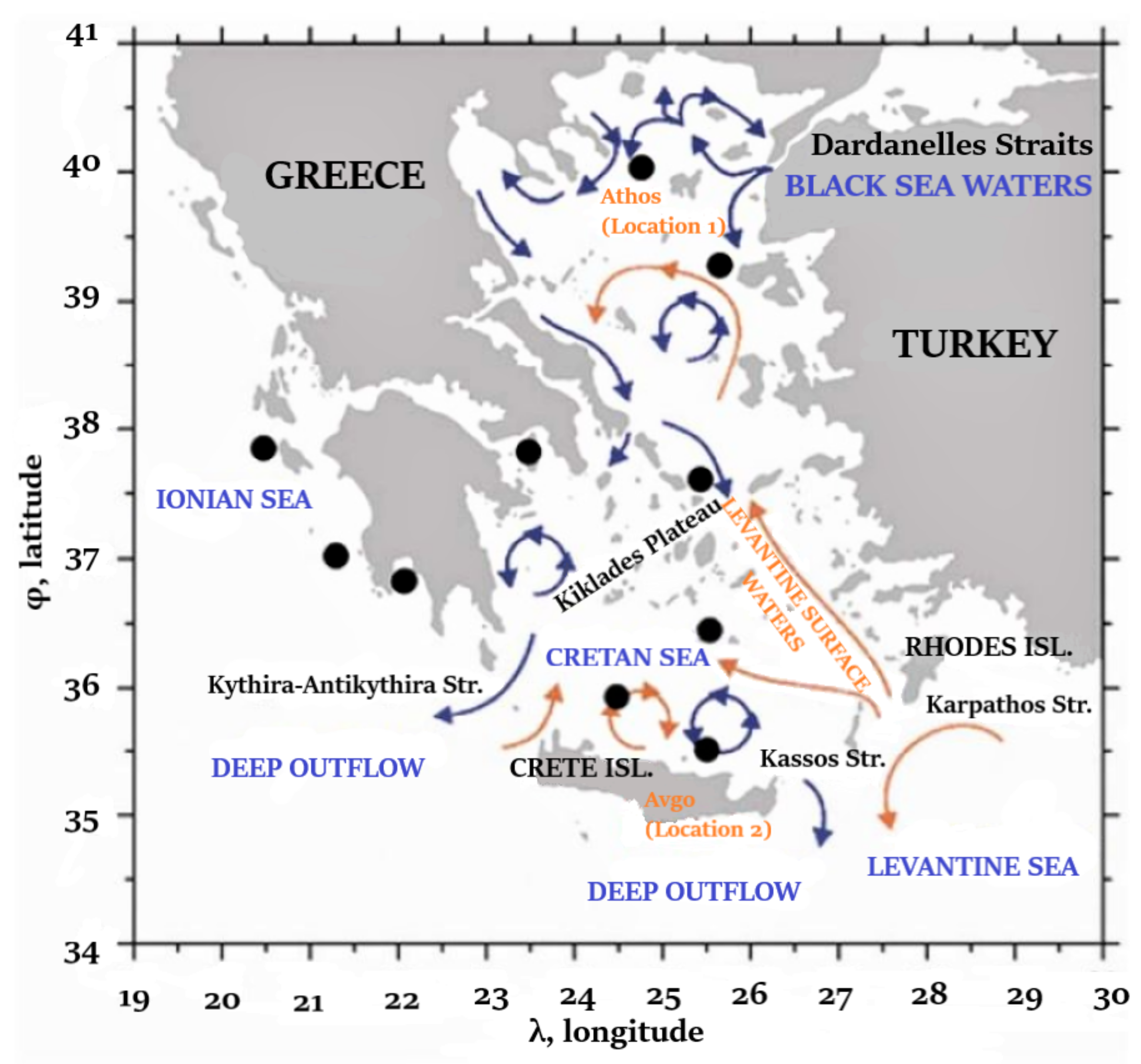






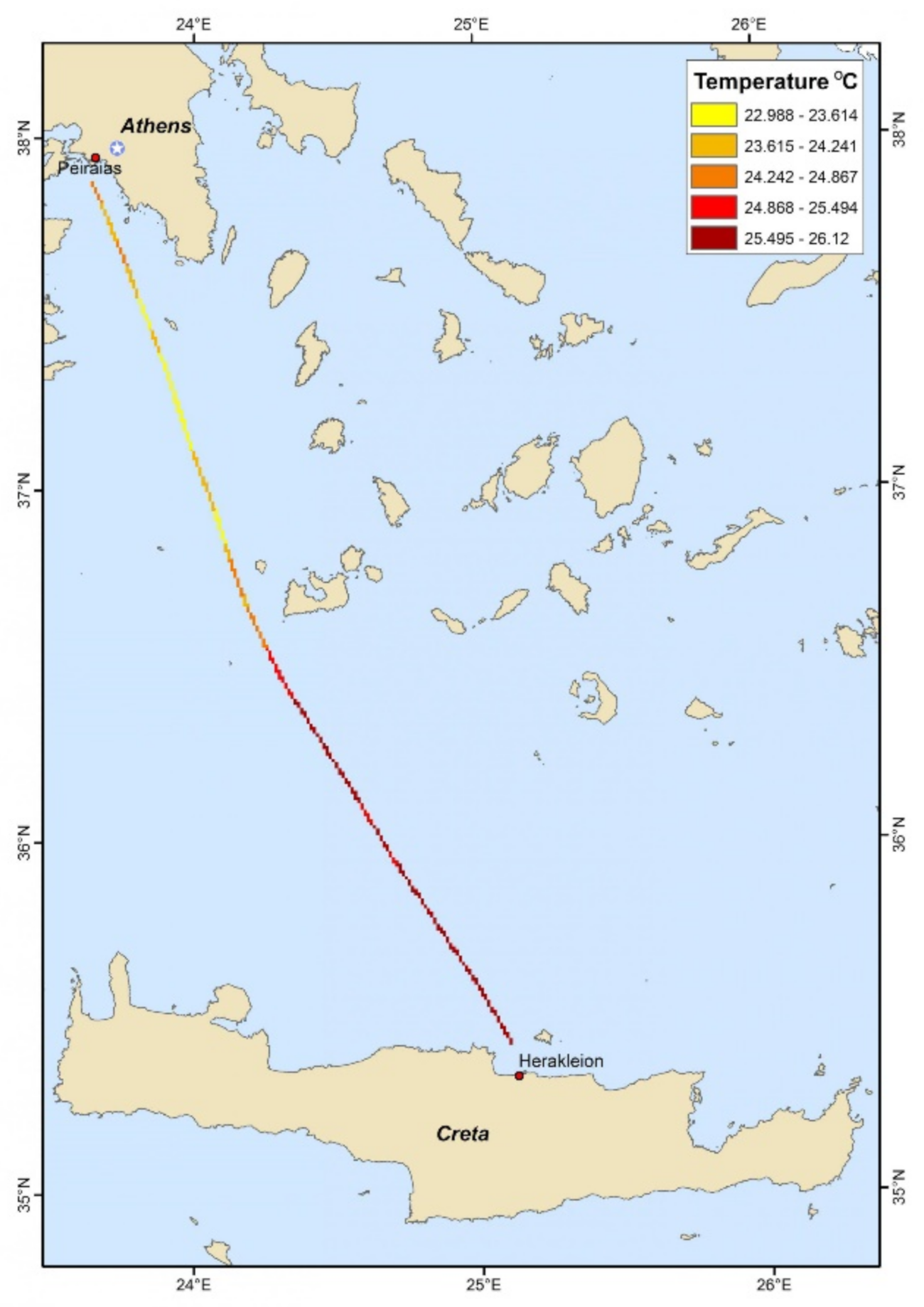

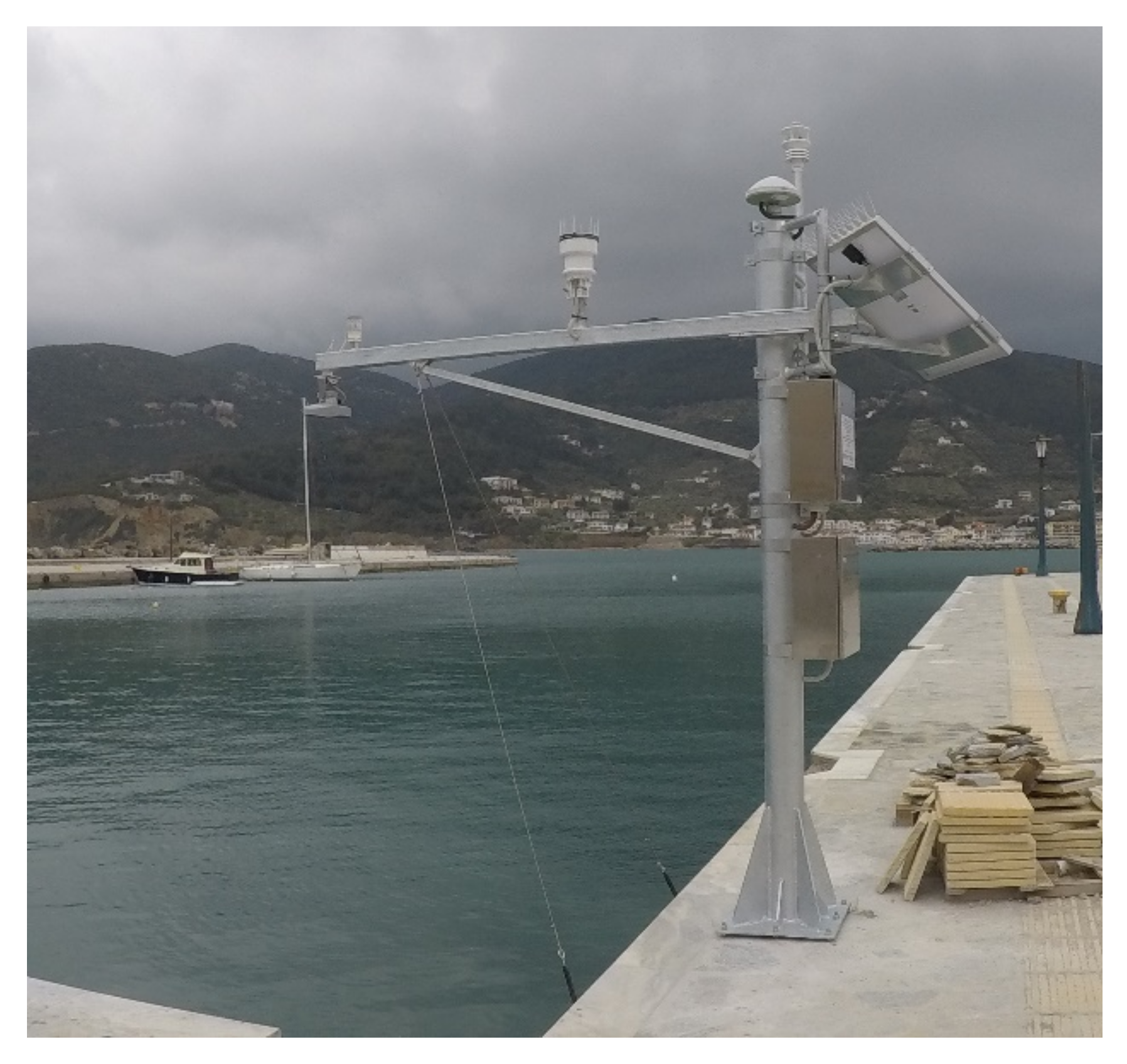
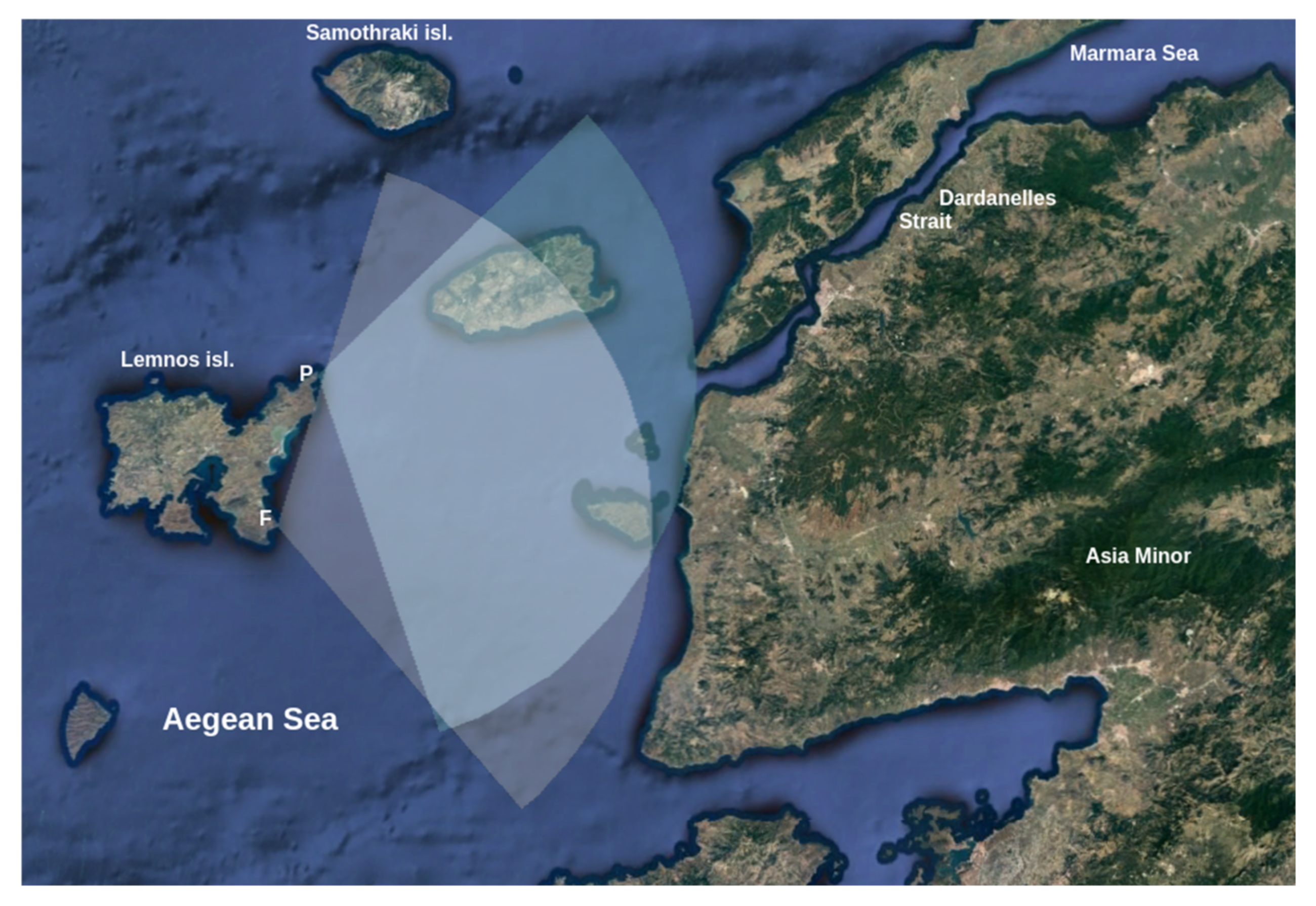

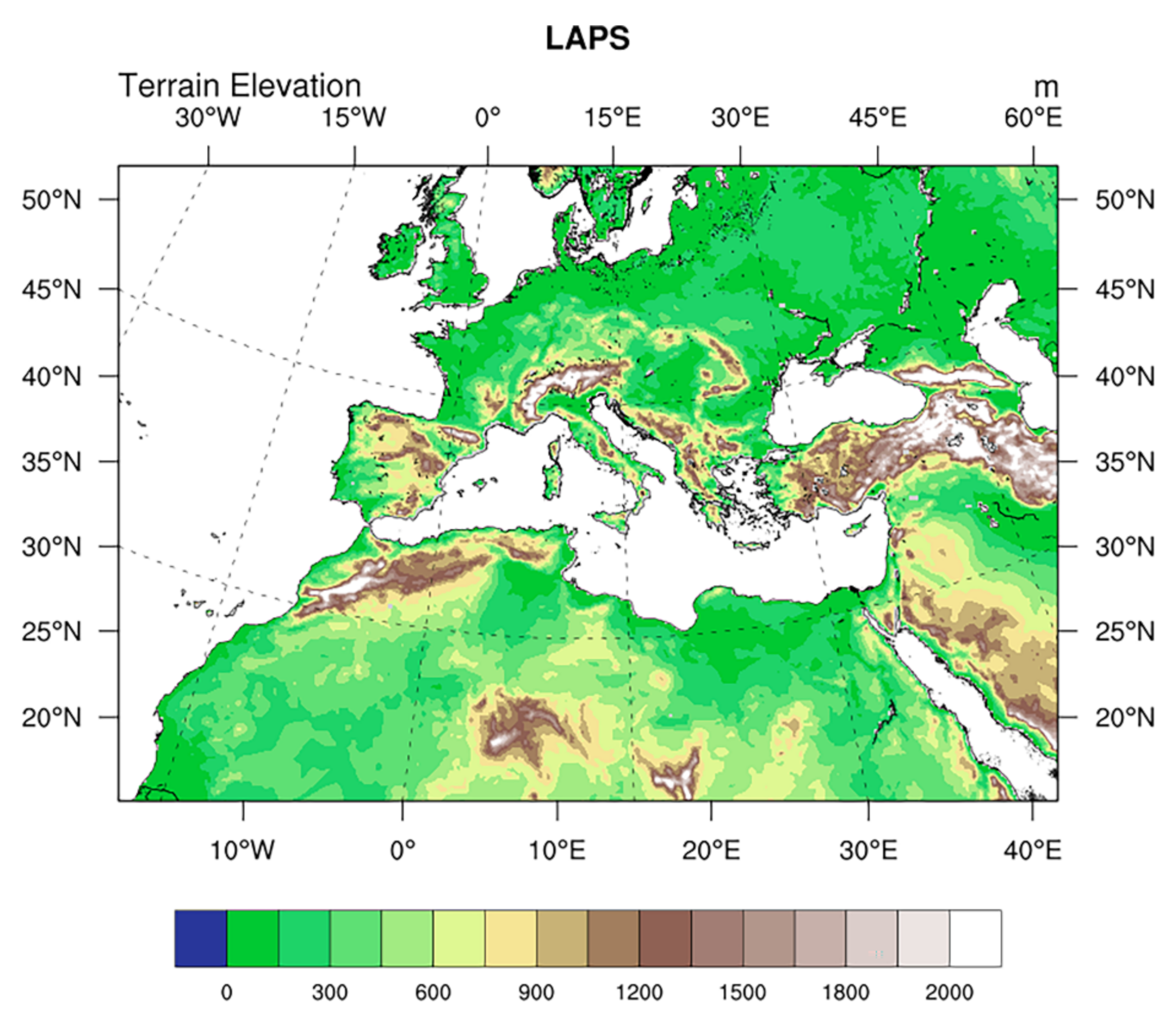

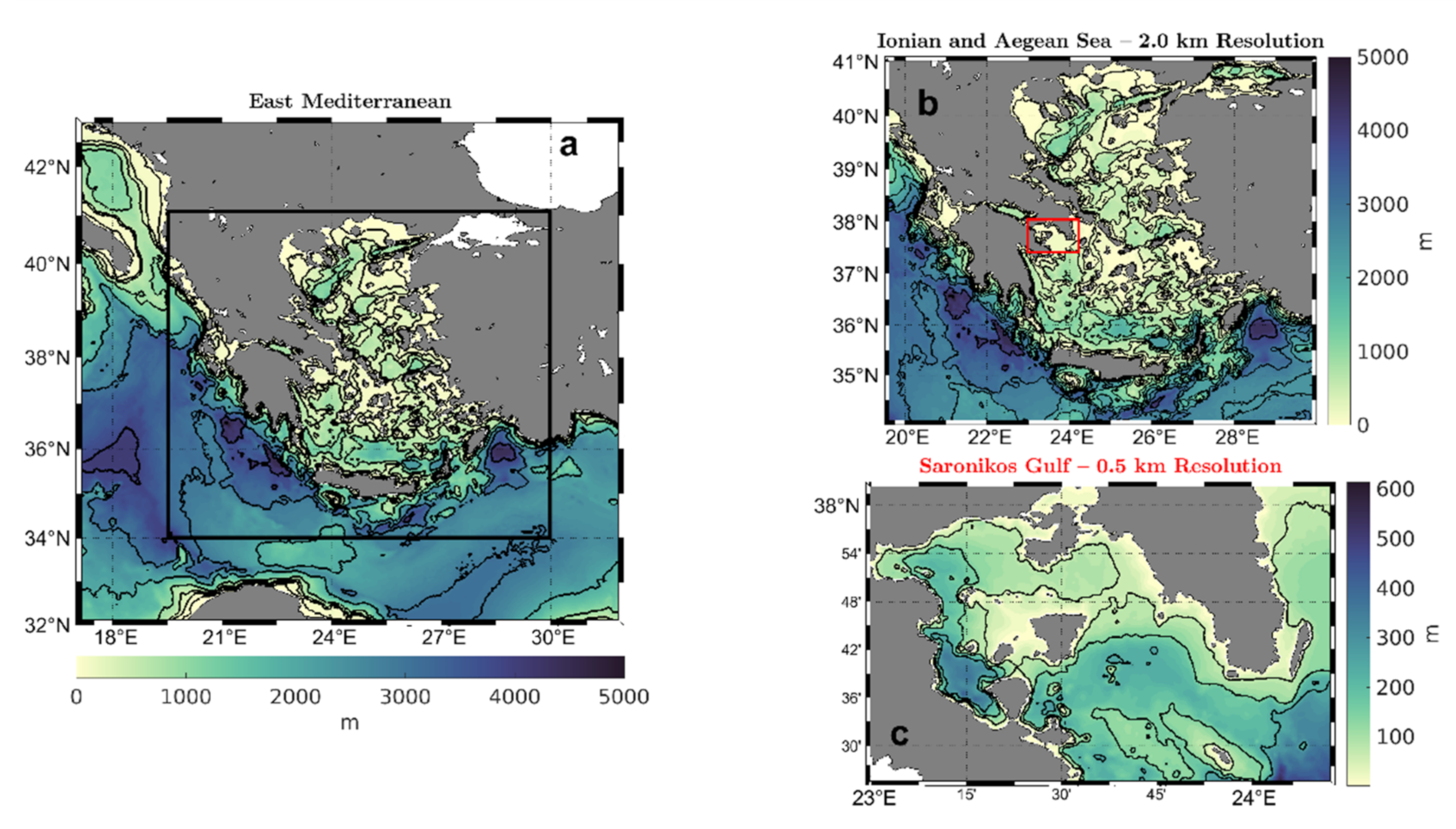
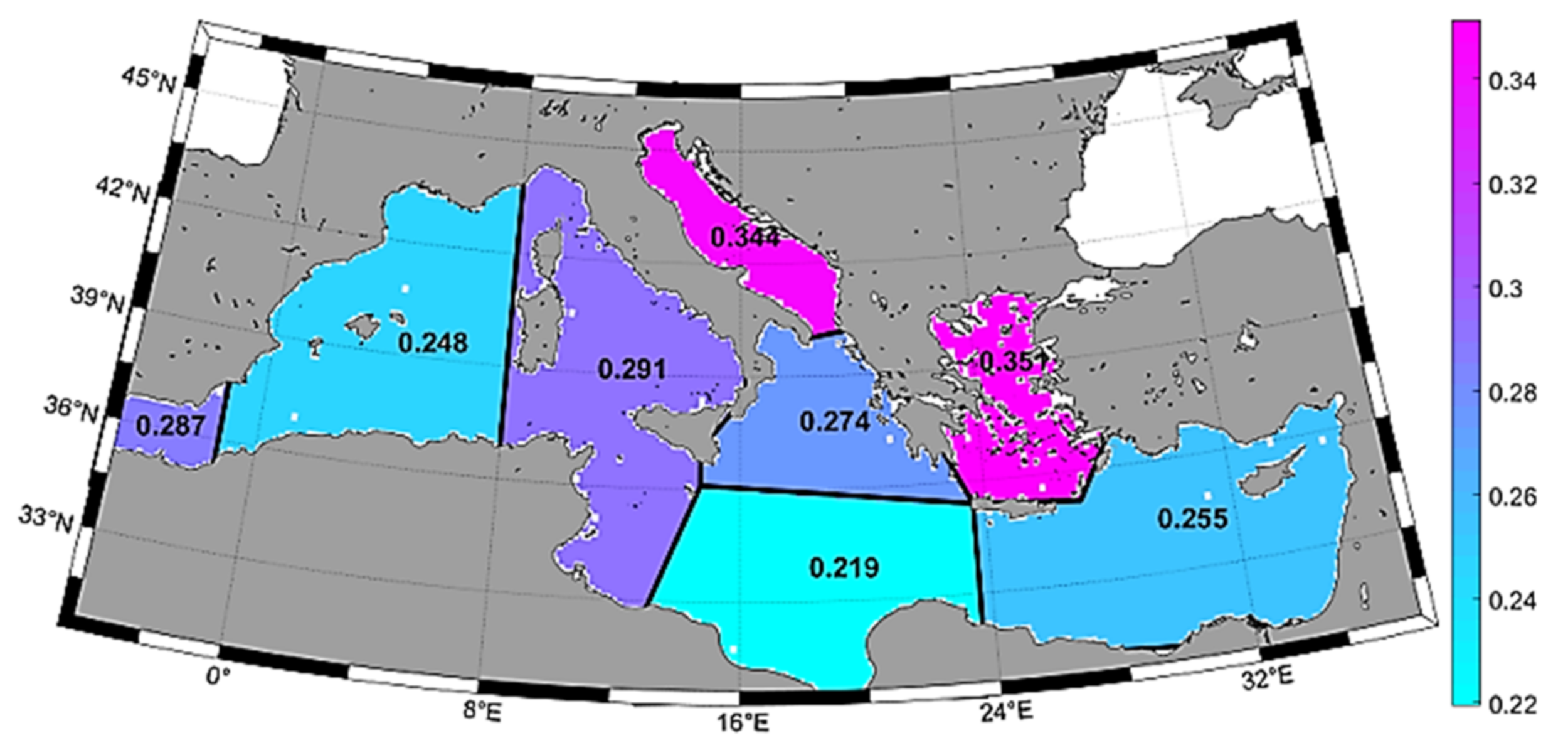
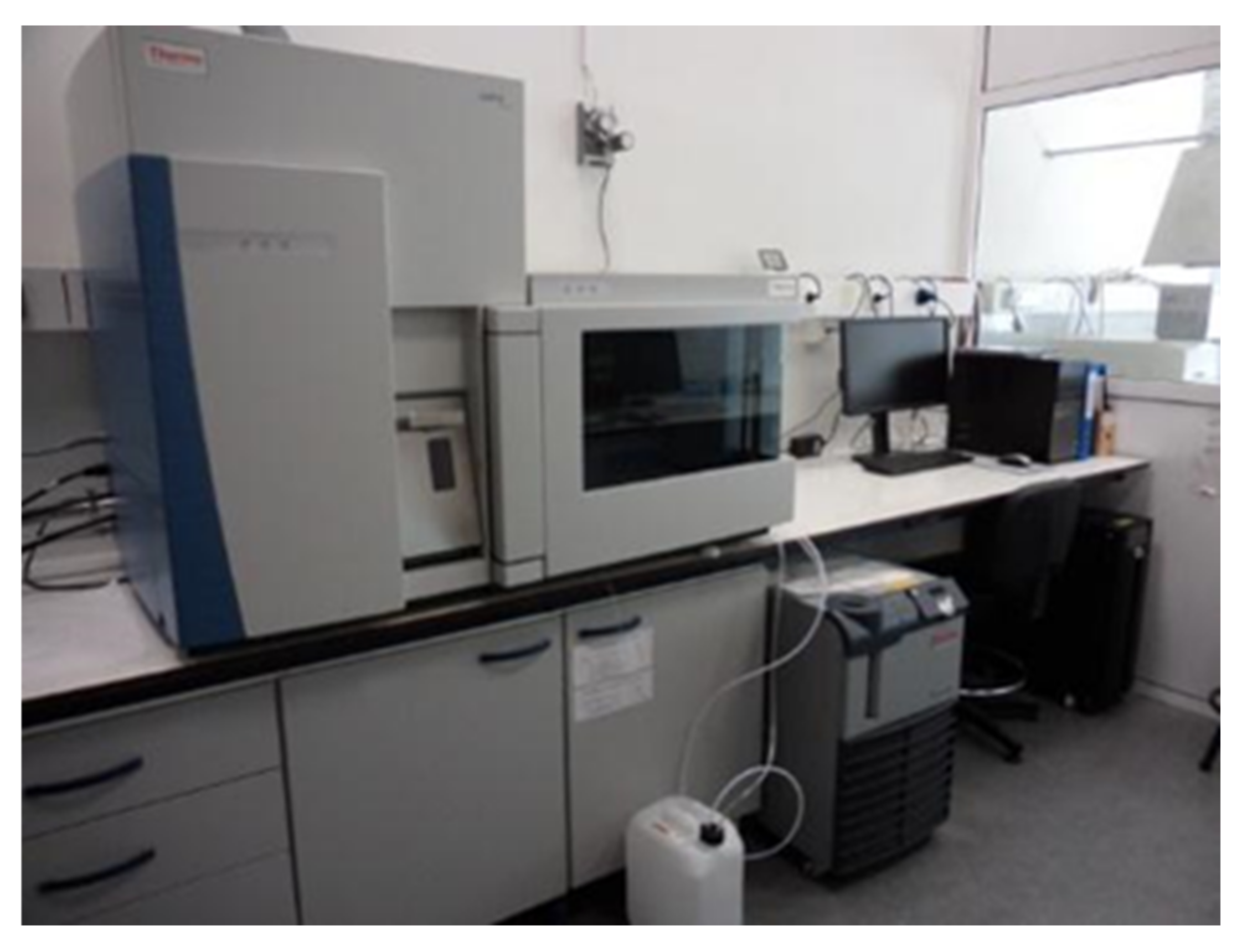
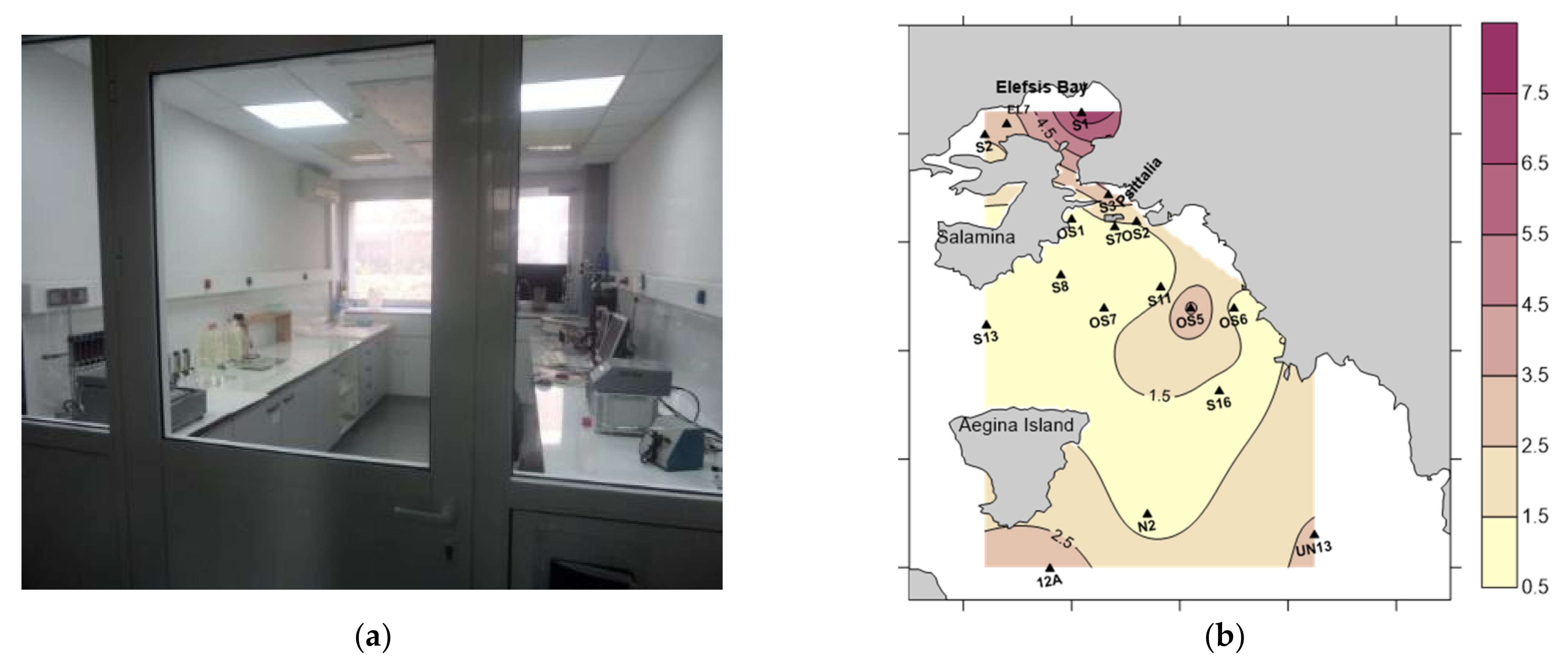
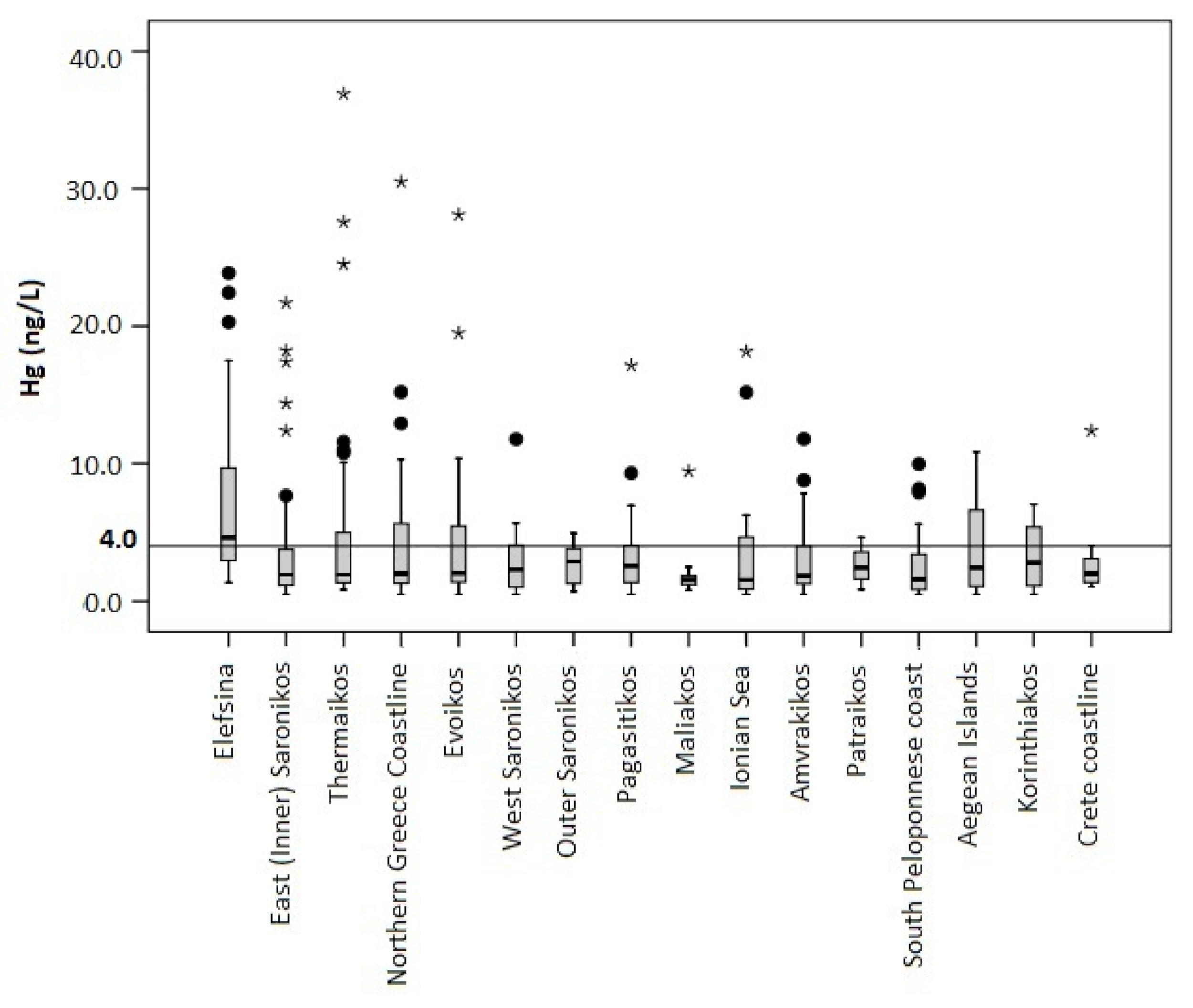

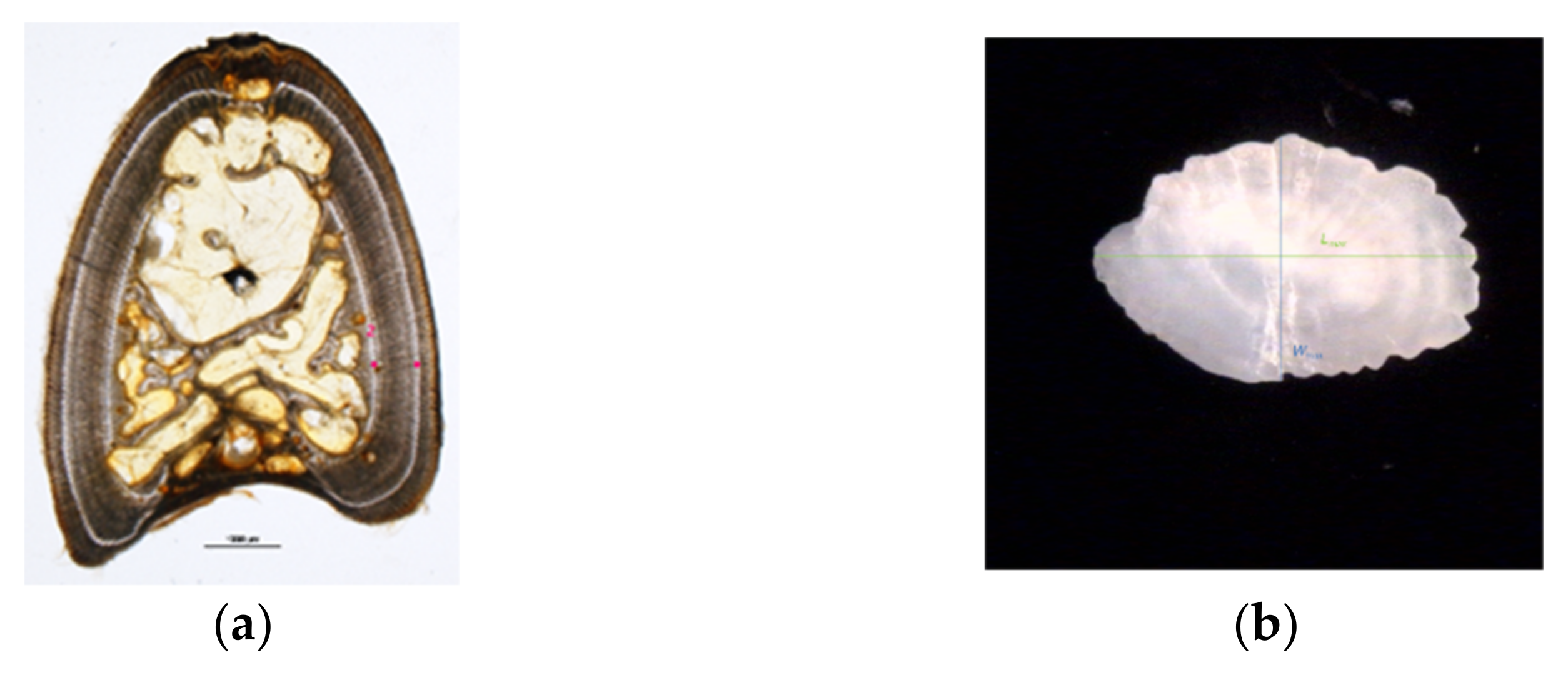







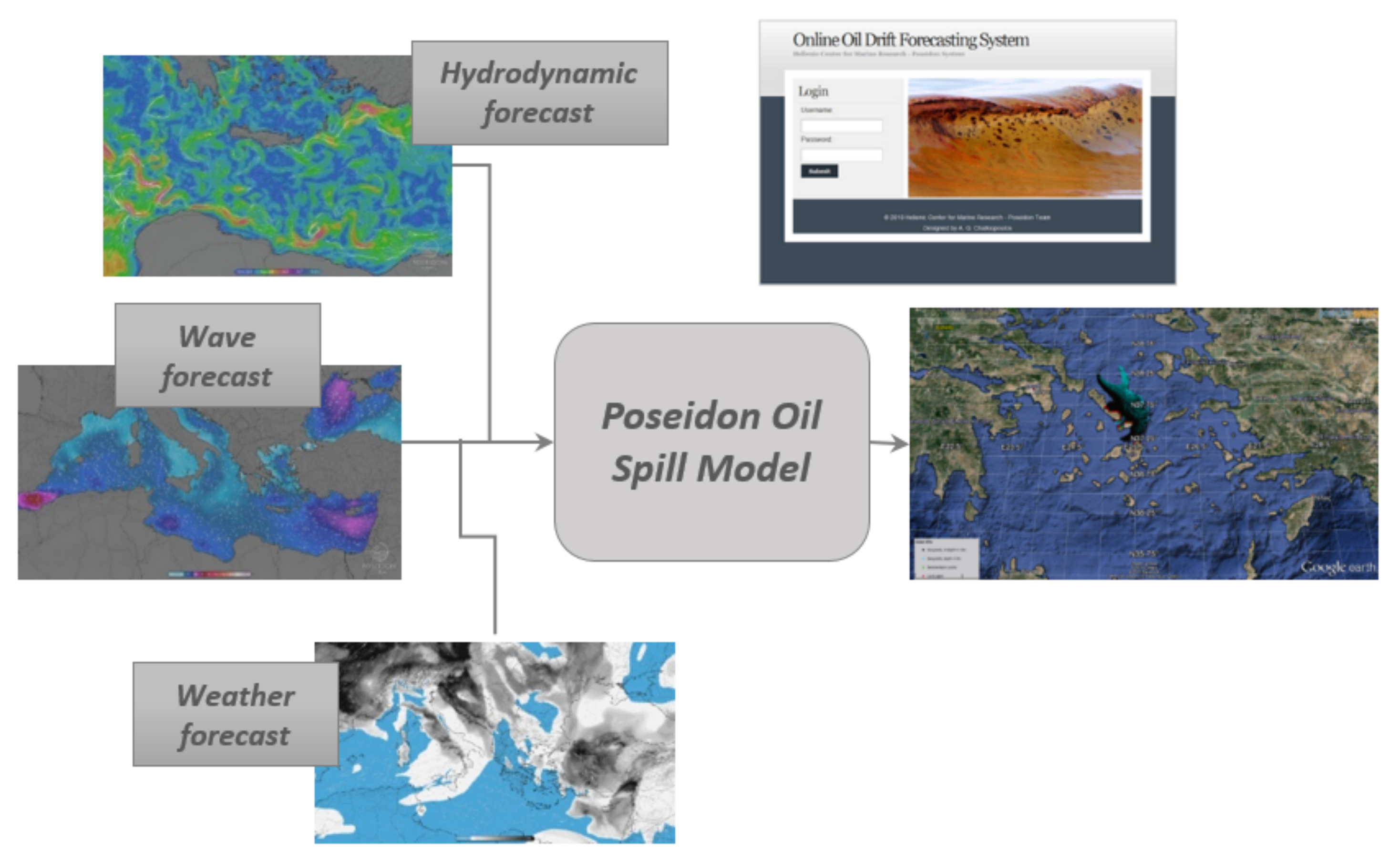




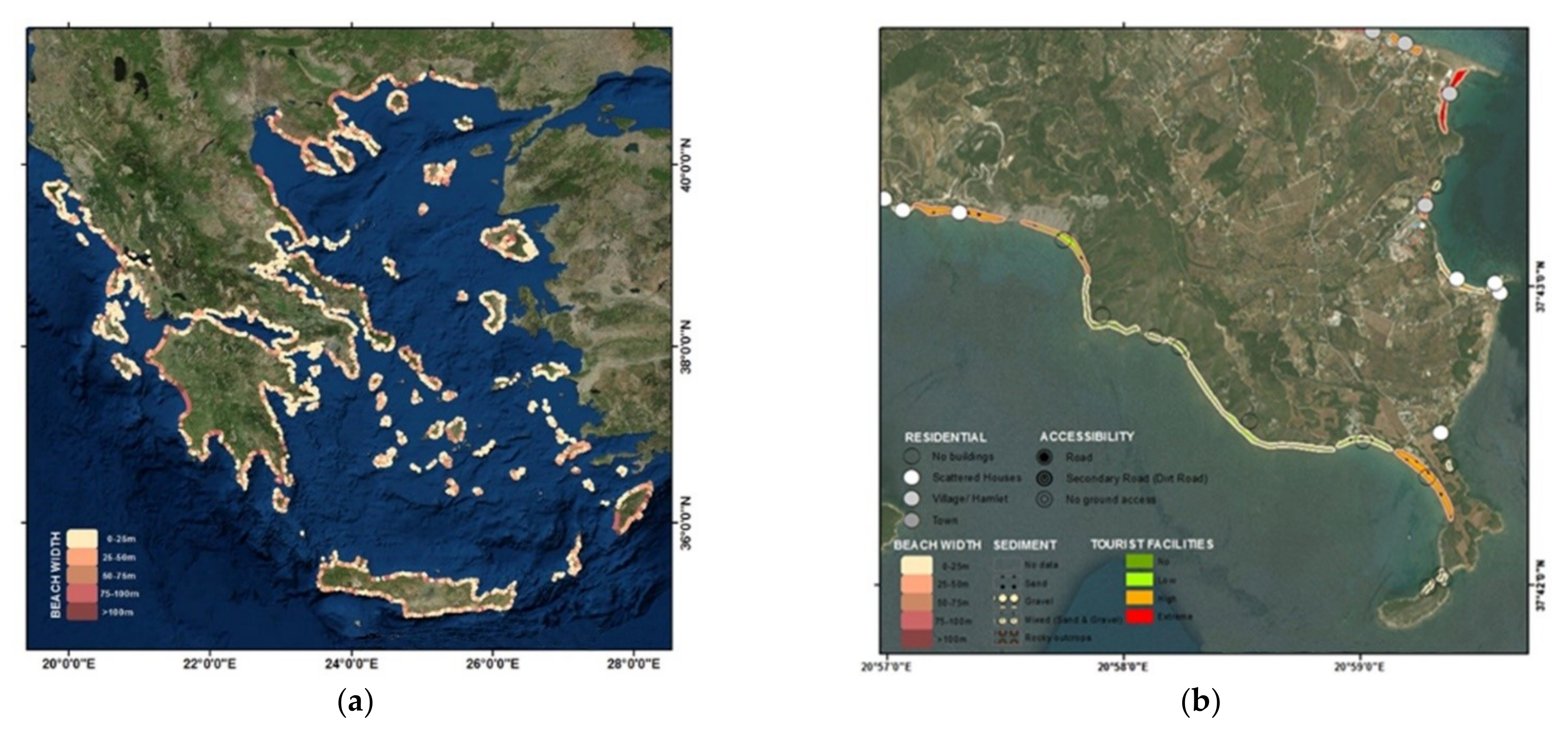
| Buoy | Athos | Saronikos | Mykonos | Pylos | E1M3A | Heraklion |
|---|---|---|---|---|---|---|
| Position | Latitude: 39.975- Longitude: 24.7294 | Latitude: 37.6099-Longitude: 23.5669 | Latitude: 37.5194-Longitude: 25.4597 | Latitude: 36.8288-Longitude: 21.6068 | Latitude: 35.7263-Longitude: 25.1307 | Latitude: 35.4342-Longitude: 25.0792 |
| Parameters | Atmospheric Sea Temperature Salinity-Conductivity Currents Waves Optical Biochemical | Atmospheric Sea Temperature Salinity-Conductivity Currents Waves | Atmospheric Sea Temperature Salinity-Conductivity Currents Waves | Atmospheric Sea Temperature Salinity-Conductivity Currents Waves Optical Biochemical | Atmospheric Sea Temperature Salinity-Conductivity Currents Waves Optical | Atmospheric Sea Temperature Salinity-Conductivity Currents Waves Biochemical |
| Depth | 100 m | 3 m | 3 m | 1000 m | 1000 m | 3 m |
| Sampling Frequency | 3 h | 3 h | 3 h | 3 h | 3 h | 3 h |
| Status | Active | Terminated (last date: 1 August 2019) | Active | Active | Active | Active |
| Deployment Date | 25 May 2000 | 27 Auguest 2007 | 1 January 2001 | 9 November 2007 | 28 May 2007 | 15 July 2016 |
| Percentage of missing data | Air Temperature: 24.3% Sea Temperature: 34.52% Salinity-Conductivity: 40.8% | Air Temperature: 49.7% Sea Temperature:51.2% Salinity-Conductivity: 53.2% | Air Temperature: 49.8% Sea Temperature:61.9% Salinity-Conductivity: 61.6% | Air Temperature: 34.7% Sea Temperature: 40.01% Salinity-Conductivity: 42.87% | Air Temperature:47.9% Sea Temperature: 37.17% Salinity-Conductivity: 38.44% | Air Temperature: 29.9% Sea Temperature: 47.2% Salinity-Conductivity: 52.4% |
| Geographical Area | Number of Float Deployments | Number of Operational Floats | Floats’ Ids | Total Mission Days | Total Profile Number | Average Profile Number per Float |
|---|---|---|---|---|---|---|
| South Ionian | 2 | 7 | 6901882 6901885 6901887 6901889 6903282 6903153 | 4047 | 665 | 95 |
| North Ionian | 2 | 4 | 6901882 6901883 6903153 | 884 | 176 | 44 |
| South Aegean | 15 | 18 | 6900795 6901881 6901885 6901886 6903152 6903276 6903277 6903278 6903280 6903281 6903282 6903284 6903286 6903287 6903289 6903290 6903291 6903296 | 3823 | 756 | 42 |
| North Aegean | 13 | 13 | 6901884 6901888 6901890 6903152 6903275 6903278 6903279 6903283 6903284 6903285 6903288 6903297 6903298 | 3332 | 741 | 57 |
| Levantine | 1 | 4 | 6901889 6903153 6903276 6903296 | 1236 | 244 | 61 |
| Adriatic | 0 | 2 | 6901882 6901883 | 250 | 50 | 25 |
| Mission | Parameters | Deployment Date | Mission Duration | Maximum Depth (m) | Horizontal Distance Covered | Number of Profiles |
|---|---|---|---|---|---|---|
| 1 | Sea Temperature Salinity-Conductivity Biochemical | 31/10/2017 | 35 days | 700 | 760 km | 682 |
| 2 | Sea Temperature Salinity-Conductivity Biochemical | 30/01/2018 | 36 days | 700 | 575 km | 776 |
| 3 | Sea Temperature Salinity-Conductivity Biochemical | 03/04/2018 | 45 days | 700 | 824 km | 750 |
| 4 | Sea Temperature Salinity-Conductivity Biochemical | 07/06/2018 | 40 days | 700 | 768 km | 702 |
| 5 | Sea Temperature Salinity-Conductivity Biochemical | 20/11/2018 | 26 days | 1000 | 675 km | 426 |
| 6 | Sea Temperature Salinity-Conductivity Biochemical | 04/03/2019 | 31 days | 1000 | 686 km | 446 |
| 7 | Sea Temperature Salinity-Conductivity Biochemical | 03/07/2019 | 29 days | 1000 | 619 km | 376 |
| 8 | Sea Temperature Salinity-Conductivity Biochemical | 21/11/2019 | 16 days | 700 | 348 km | 362 |
| 9 | Sea Temperature Salinity-Conductivity Biochemical | 11/03/2020 | 42 days | 1000 | 935 km | 514 |
| 10 | Sea Temperature Salinity-Conductivity Biochemical | 03/07/2020 | 35 days | 1000 | 779 km | 476 |
| 11 | Sea Temperature Salinity-Conductivity Biochemical | 22/04/2021 | 36 days | 700 | 718 km | 540 |
 Heraklion).
Heraklion).| Route | Start Date | End Date | Parameters | Sampling Frequency | Number of Cruises |
|---|---|---|---|---|---|
| Piraeus Heraklion | 20 June 2012 | 10 October 2014 | Sea Temperature Salinity-Conductivity Optical Biochemical | 1 min | 280 |
| Piraeus Heraklion | 28 September 2017 | 18 January 2018 | Sea Temperature Salinity-Conductivity Optical Biochemical | 1 min | 84 |
| Piraeus Heraklion | 1 April 2018 | 12 October 2018 | Sea Temperature Salinity-Conductivity Optical Biochemical | 1 min | 134 |
| Pylos Site | |
|---|---|
| Location | Latitude: 36.8347 Longitude: 21.6139 |
| Depth | 1580 m |
| Installation Date | 22 May 2018 |
| Parameters | Conductivity Temperature Pressure Chlorophyll-a Dissolved oxygen Dissolved carbon dioxide Turbidity Acidity (pH) |
| Additional sensors and equipment | Supersensitive pressure sensor to detect tsunami waves Subsurface water Currents Measuring Instrument (ADCP 600 m) Ambient sound recorder Seismograph (OBS) Gravimeter Lighting system Picture and video recording system |
| Skopelos Island | Palaia Fokea | |
|---|---|---|
| Position | Latitude: 39.1238 Longitude: 23.7297 | Latitude: 37.7175 Longitude: 23.9452 |
| Available Parameters | Atmospheric, Sea level | Atmospheric, Sea level |
| Sampling Frequency | Atmospheric: 10 min Sea level: 5 min | Atmospheric: 10 min Sea level: 5 min |
| Installation Date | 16 April 2021 | 22 March 2021 |
| Status | active | active |
| Efficiency of Data Acquisition | Atmospheric: 87.8% Sea level: 96.27% | Atmospheric: 99.4% Sea level: 98.04% |
| Plaka Station | Fisini Station | |
|---|---|---|
| Position—Latitude | 40°02′06″ N | 39°48′54″ N |
| Position—Longitude | 025°26′48″ E | 025°22′12″ E |
| Central Lobe Azimuth | 98° | 65° |
| Parameters | Sea-Surface Current Velocity Wave Parameters | |
| Transmission Frequency | 16.15 MHz | |
| Repetition Cycle | 30 min | |
| Samples per data run | 4096 | |
| Maximum Range | 96 km | |
| Rx antennas per site | 8 | |
| 3D-Var Data Assimilation Model (LAPS) | |
|---|---|
| Integration domain | Europe, North Atlantic, North Africa, Middle East, Western Russia |
| Grid structure | Lambert conformal |
| Horizontal resolution | 15 × 15 km |
| Vertical resolution | 22 pressure levels |
| Ingested data | METAR, SYNOP, RAOB |
| Background fields | Time-dependent near-to-analysis global forecasts at 0.5°× 0.5° resolution from NCEP/GFS with a 3 h time increment |
| Operational suite | Hourly analyses |
| Atmospheric Model (Non-Hydrostatic ETA) | |
|---|---|
| Integration domain | Europe, North Atlantic, North Africa, Middle East |
| Grid structure | Arakawa semi-staggered E-grid defined in transformed lat/lon coordinate system |
| Horizontal resolution | 0.05° × 0.05° (0.24° × 0.24° for the dust module) |
| Vertical resolution | 50 ETA levels |
| Basic time step | 18 s |
| Initial condition | LAPS analyses (see Table 1) |
| Boundary conditions | Time-dependent global forecasts at 0.5° × 0.5° resolution from NCEP/GFS with a 3 h time increment |
| Model | IAS | Saronikos Gulf |
|---|---|---|
| Coupled | No | Yes—SWAN |
| Horizontal resolution | 2.0 km | 0.5 km |
| Vertical resolution | 30 sigma level | 20 sigma level |
| Mixing Scheme | Mellor Yamada 2.5 | Mellor Yamada 2.5 |
| Assimilation Scheme | 4D-VAR (RBL4D-Var) | No |
| Tides | Yes | Yes |
| Atmospheric forcing | POSEIDON ETA/Skiron | POSEIDON ETA/Skiron |
| Riverine outflow | SHMI E-HYPE model | No |
| Lateral boundary conditions | CMEMS MED-Currents | IAS forecast/Aegean WAM forecast |
| Infrastructure | Models/Specifications |
|---|---|
| Double beam UV-VIS Spectrophotometers | Varian Cary 1E Specord 210 Plus (1 and 5 cm optical length) |
| Ion chromatographer [41] | Metrohm 820 IC Separator 551 Center, 819 IC Detector |
| Atomic absorption spectrometers | Graphite Furnace Varian SpectrAA-640Z-GTA-100 Flame Varian SpectrAA-200 |
| ICP-MS | Thermo Scientific ICAP Qc |
| Laminar flow cabinet 570 CLEAN ROOM | Class 10000 |
| Cold-vapor atomic fluorescence spectrometer (CVAFS) | TEKRAN 2500 |
| In situ physicochemical measurement devices | YSI 63 portable (pH, salinity, temperature), Lovibod SD310 Oxi meter |
| Sampling devices | Birge Eckman sediment grab, Mackereth corer, Niskin type andRuttner type plastic water samplers |
| Cruise | Parameters | Sampling Dates | Cruise Duration | Sampling Area | Number of Samples |
|---|---|---|---|---|---|
| 1 | Total Hg in seawater | October 2017 | 3 days | Saronikos Gulf | 35 |
| 2 | March 2018 | 7–10 days | Greek WFD monitoring station grid | 30 | |
| 3 | October 2018 | 7–10 days | 32 | ||
| 4 | March 2019 | 7–10 days | 30 | ||
| 5 | October 2019 | 7–10 days | 32 | ||
| 6 | March 2018 | 7–10 days | 42 | ||
| 7 | October 2020 | 7–10 days | 43 |
| Infrastructure | Models/Specifications |
|---|---|
| Underwater drone | GLADIUS MINI Underwater Drone Maximum Recording Depth: 200 m, Speed: 2 m/s, 4K Ultra HD Camera |
| Aerial drone | DJI Mavic 2 Pro Sensor: 1″ CMOS Effective Pixels/20 million Video Resolution: 4K, FHD, Max Speed: 72 Km/h, Maximum Takeoff Altitude: 6000 m, Operating Temperature Range: −10 °C to 40 °C |
| Image Analysis System | Image-Pro Plus v. 6.0 software, stereoscope or optical microscope, digital or analogue camera |
| Archival tags | Mk9 Archival Tags (Wildlife Computers) Size: 72 × 19 mm/Weight: 34 g, Pressure Resistance: 1000 m. Memory and Data Retention: 64 MB Depth/A 12-bit analog to digital converter, measurements from −40 to 1000 m, (resolution 0.5 m, accuracy of ±1%) Temperature/A 12-bit analog to digital actual measured range of −40 °C to 60 °C, (0.05 °C resolution and an accuracy of ±0.1 °C). |
| Microtome, embedding station & flotation bath | Manually operated microtome for thin sections (6–8 μm) (Leica RM2235). Advanced paraffin embedding station with microprocessor control system (Leica EG1150H). Paraffin flotation bath for flattening and drying sectioned tissues (Leica HI1210) |
| Infrastructure | Models/Specifications |
|---|---|
| Single beam echosounder coupled with Sidescan Sonar | Maximum Recording Depth: ~300 m. Triple Sounding Frequency (455, 800 and 1200 kHZ), for bottom scanning up to 120, 40 and 60 m, Scanning swath of about 300 m GNSS receiver (10 Hz with EGNOS and GLONASS) preinstalled nautical charts |
| Autonomous Weather Station (Wireless) | Temperature (Range: 0° to +60 °C, Resolution 0.1 °C) Barometric Pressure (410 to 820 mm Hg, Resolution 0.1 mm Hg), Humidity (Range: 1 to 100% 663 RH, Resolution 1%), Rain (Range: 0 to 6553 mm, Resolution 0.2 mm) |
| Autonomous Beach Imaging System | Calibrated/coupled with RTK-DGPS topographical mapping and 3D laser |
| Type of Data | Total Stations | Parameters | Sampling Frequency |
|---|---|---|---|
| Geological | 183 | coastal zone topography, bathymetry, seabed morphology, sedimentology |
|
| Chemical | 207 | nutrients, trace metals in seawater and sediments |
|
| Biological | 55 | recordings of the presence and distribution of endangered species, Cartilaginous species, marine mammals, overfished species, jellyfish recordings of human activities (e.g., fisheries, aquaculture, industry, tourism) and their impact on biological resources |
|
Publisher’s Note: MDPI stays neutral with regard to jurisdictional claims in published maps and institutional affiliations. |
© 2022 by the authors. Licensee MDPI, Basel, Switzerland. This article is an open access article distributed under the terms and conditions of the Creative Commons Attribution (CC BY) license (https://creativecommons.org/licenses/by/4.0/).
Share and Cite
Bourma, E.; Perivoliotis, L.; Petihakis, G.; Korres, G.; Frangoulis, C.; Ballas, D.; Zervakis, V.; Tragou, E.; Katsafados, P.; Spyrou, C.; et al. The Hellenic Marine Observing, Forecasting and Technology System—An Integrated Infrastructure for Marine Research. J. Mar. Sci. Eng. 2022, 10, 329. https://doi.org/10.3390/jmse10030329
Bourma E, Perivoliotis L, Petihakis G, Korres G, Frangoulis C, Ballas D, Zervakis V, Tragou E, Katsafados P, Spyrou C, et al. The Hellenic Marine Observing, Forecasting and Technology System—An Integrated Infrastructure for Marine Research. Journal of Marine Science and Engineering. 2022; 10(3):329. https://doi.org/10.3390/jmse10030329
Chicago/Turabian StyleBourma, Evi, Leonidas Perivoliotis, George Petihakis, Gerasimos Korres, Constantin Frangoulis, Dionysios Ballas, Vassilis Zervakis, Elina Tragou, Petros Katsafados, Christos Spyrou, and et al. 2022. "The Hellenic Marine Observing, Forecasting and Technology System—An Integrated Infrastructure for Marine Research" Journal of Marine Science and Engineering 10, no. 3: 329. https://doi.org/10.3390/jmse10030329
APA StyleBourma, E., Perivoliotis, L., Petihakis, G., Korres, G., Frangoulis, C., Ballas, D., Zervakis, V., Tragou, E., Katsafados, P., Spyrou, C., Dassenakis, M., Poulos, S., Megalofonou, P., Sofianos, S., Paramana, T., Katsaounis, G., Karditsa, A., Petrakis, S., Mavropoulou, A.-M., ... Zissis, N. (2022). The Hellenic Marine Observing, Forecasting and Technology System—An Integrated Infrastructure for Marine Research. Journal of Marine Science and Engineering, 10(3), 329. https://doi.org/10.3390/jmse10030329














